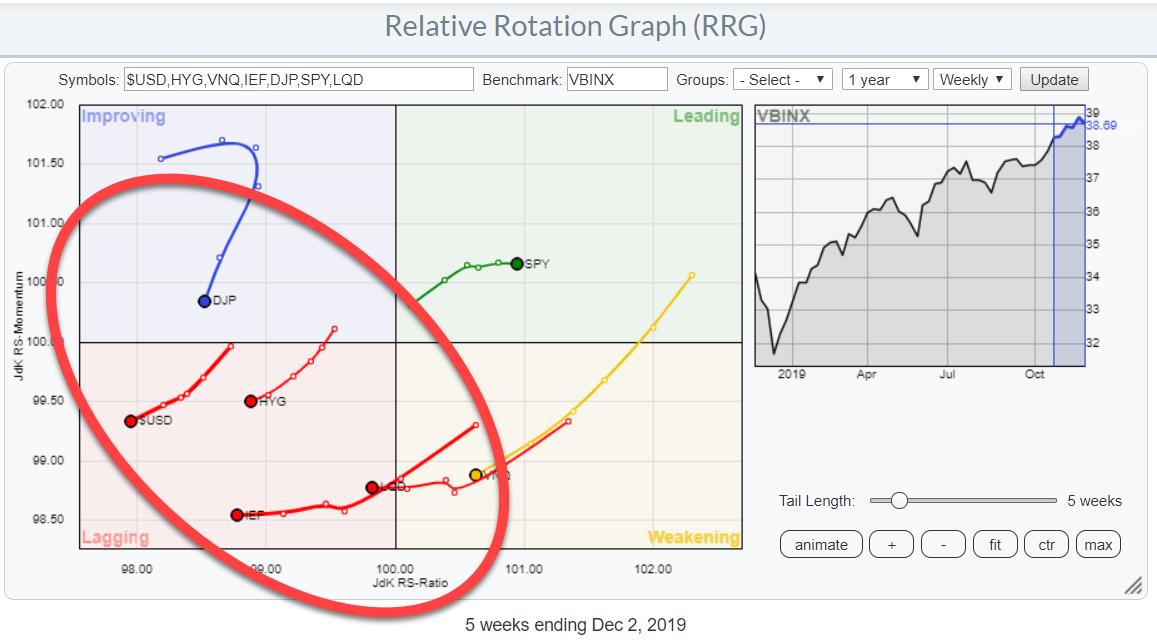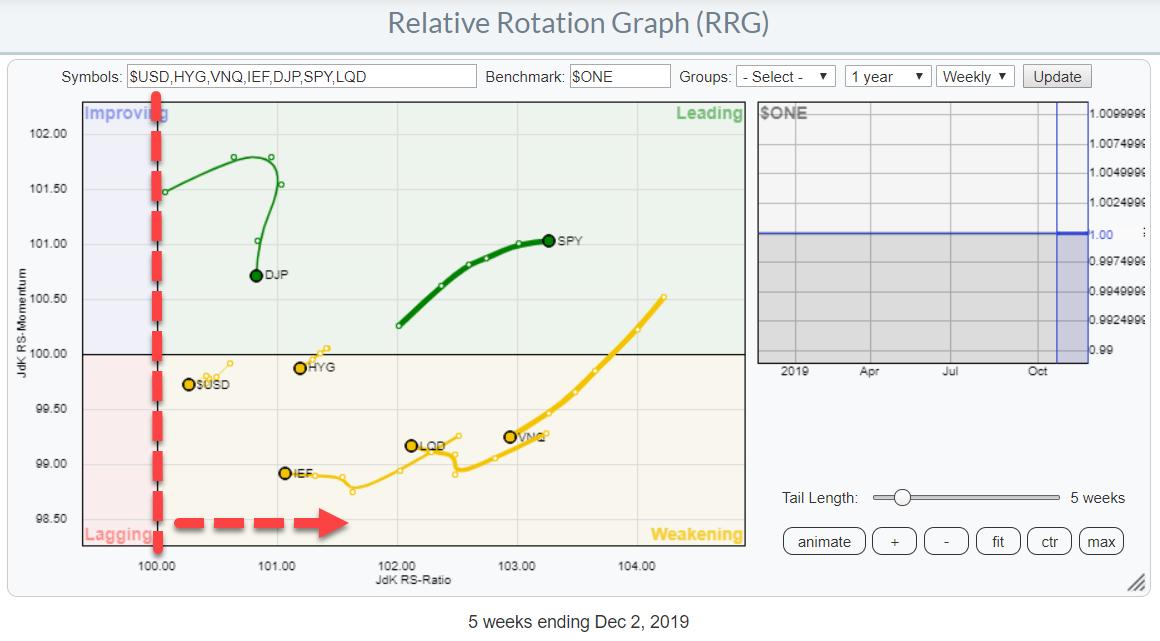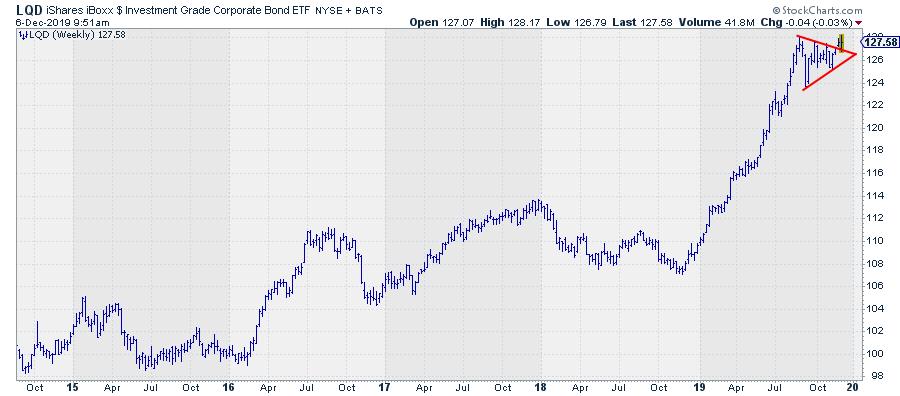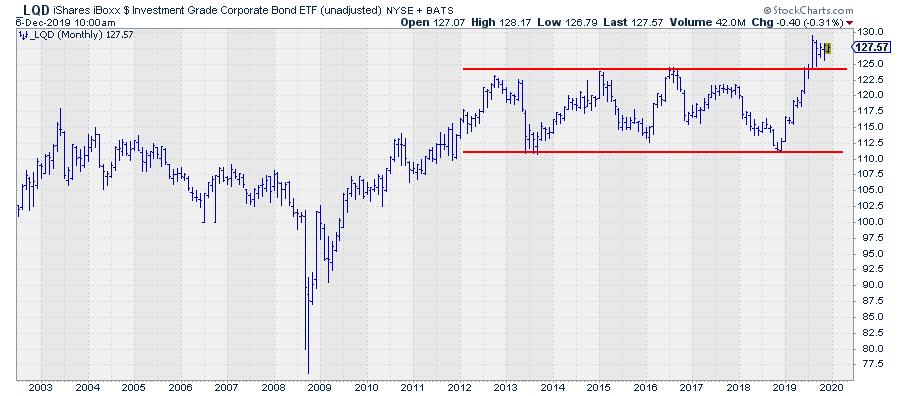
This article also appeared in our ChartWatchers newsletter (12/7).
Last Wednesday, I published an article in the RRG Charts blog titled "Stocks Remain The Only Asset Class Inside The Leading Quadrant Going into December". As the title suggests, that article primarily looks at the rotation for asset classes and has an in-depth analysis of the long-term chart of SPY.
Asset Class Rotation vs $ONE
The Relative Rotation Graph above again shows the rotation (weekly) for asset classes. With SPY as the only one inside the Leading quadrant, what does that mean for other asset classes? Where do you go when you don't want to be 100% invested in stocks and would like to have some diversification in your portfolio?
In this graph, the benchmark is the 60/40 balanced portfolio (VBINX) and clearly that stocks are the best asset class from a relative perspective.
When we change the benchmark to $ONE which shows us the trend in absolute terms, $ONE is a benchmark that never goes down, meaning we see that all asset classes are on the right-hand side of the RRG plot.

This means that the other asset classes, even though they are under-performing stocks, are still showing mildly positive trends. So they aren't as bad as it may seem at first sight.

Over the past five weeks, LQD and HYG are also showing a positive return. The worst returns have come from Real Estate and Commodities.
LQD Pops (Up)
LQD, in particular, is showing an interesting chart at the moment IMHO. Below is the adjusted chart:

This weekly chart shows the strong uptrend since the start of 2019 and the recent consolidation (pennant, triangle, etc.) which we are now leaving to the upside. That is good news, as it suggests a continuation of the uptrend.
As this is an asset class where a substantial portion of the return is coming from coupons - or dividends, in the case of this ETF - I also like to always study the UN-adjusted chart, as it shows the prices where people have actually traded this market. That chart shows a very different, but also positive, picture.

This the monthly unadjusted chart. As you can see, LQD has been trading in a range since 2012 and broke out of that range to the upside four months ago, where it has been consolidating since. That consolidation pattern is also visible on the weekly chart using adjusted data.
This unadjusted chart represents levels where people have actually been trading this market. In bond terms, these are the clean prices, as opposed to the dirty pricing where accrued interest is included (the adjusted price series).
For support and resistance levels, these are the levels I like to watch as they represent what is in people's minds.
The break that is visible is significant, as it is a break out of a long sideways range, meaning that a lot of tension has been built up at the edges of that range and this situation is now broken. Usually, that means an acceleration in the direction of the break, in this case upward.
The width of the range is around $ 12.50 and, to achieve a price target, we may project that figure on top of the breakout level. This exercise leads to a price target somewhere between $135.00-$137.50.
So, despite the fact that LQD is lagging behind SPY (stocks) for the time being, it can still serve as a diversifier in your portfolio if you do not want to have 100% exposure to stocks.
--Julius
Julius de Kempenaer
Senior Technical Analyst, StockCharts.com
Creator, Relative Rotation Graphs
Founder, RRG Research
Want to stay up to date with the latest market insights from Julius?
– Follow @RRGResearch on Twitter
– Like RRG Research on Facebook
– Follow RRG Research on LinkedIn
– Subscribe to the RRG Charts blog on StockCharts
Feedback, comments or questions are welcome at Juliusdk@stockcharts.com. I cannot promise to respond to each and every message, but I will certainly read them and, where reasonably possible, use the feedback and comments or answer questions.
To discuss RRG with me on S.C.A.N., tag me using the handle Julius_RRG.
RRG, Relative Rotation Graphs, JdK RS-Ratio, and JdK RS-Momentum are registered trademarks of RRG Research.
Julius de Kempenaer
Senior Technical Analyst, StockCharts.com
Creator, Relative Rotation Graphs
Founder, RRG Research
Host of: Sector Spotlight
Please find my handles for social media channels under the Bio below.
Feedback, comments or questions are welcome at Juliusdk@stockcharts.com. I cannot promise to respond to each and every message, but I will certainly read them and, where reasonably possible, use the feedback and comments or answer questions.
To discuss RRG with me on S.C.A.N., tag me using the handle Julius_RRG.
RRG, Relative Rotation Graphs, JdK RS-Ratio, and JdK RS-Momentum are registered trademarks of RRG Research.






